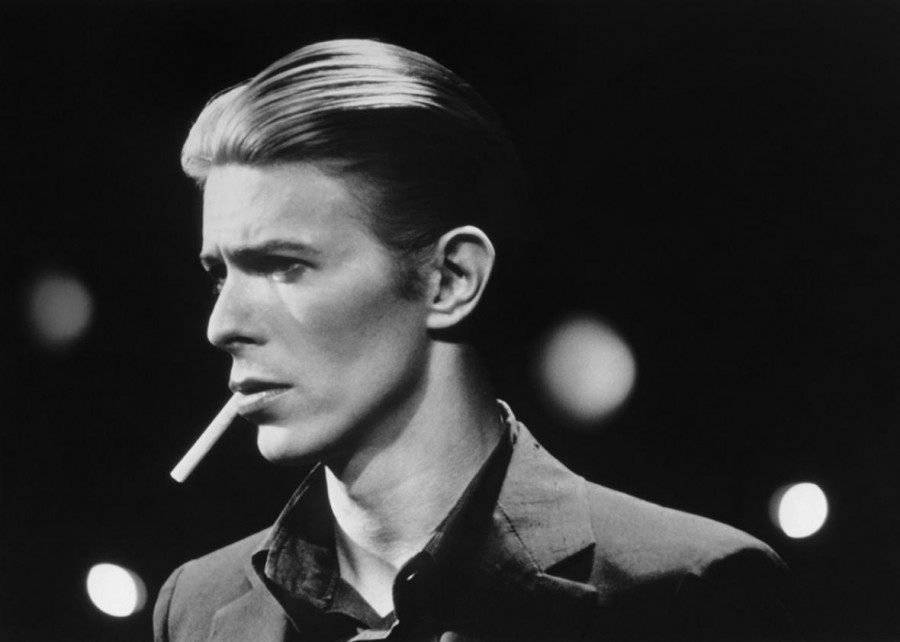“Ashes to Ashes” – An Ode to Bowie
February 4, 2016
David Bowie said “Tomorrow belongs to those who can hear it coming” in promotion for his 1977 album, Heroes. However, no one could have prepared the world for the tomorrow that was January 10, 2016. After an eighteen-month long struggle with terminal cancer, David Bowie passed away and the world commenced its mourning. The knowledge of his illness had only been shared with a select few, with the only inkling being hinted at in his latest album Black Star, which had been released on Bowie’s birthday — January 8th, 2016 — only two days before his death. Some have called the twenty-ninth album a ‘parting gift’ for fans, but nothing can truly make up for the loss of such a musically and culturally venerable man.
Known for his affinity for strange and ‘otherworldly’ fashion, as well as his skill to gyrate from genre to genre, Bowie was a master of the artistic trade. He developed multiple personas, notably Ziggy Stardust (a bisexual martian), the Thin White Duke (a sad aristocrat), and Halloween Jack (a gang member who lived in the fictional Hunger City) . He also developed a performing style that was more theatrical than that of your average onstage performance. Furthermore, while he certainly wasn’t the first gay-rocker (I believe that Little Richard is accredited with that title), Bowie paved the way for other artists to be open about their sexuality. This was especially brave considering the pervasiveness of homophobia that haunted the 1960’s. Bowie inspired countless others for generations to come in his forty-year-long career as a rock and roll legend and continues to do so in death. This is proven true, upon examining his life-story.
* * *
Born David Jones in 1947, Bowie was brought up in the London suburb of Brixton. He had always had a knack for music, having learnt the saxophone at age thirteen while attending Bromley Technical High School. There, he also developed his famous case of Heterochromia Iridum, which was the result of a schoolyard fight, making his left pupil permanently dilated. After graduating at age sixteen, Bowie began pursuing his own commercial career in music, and played saxophone with a variety of British-based mod-rock bands (The Konrads, The King Bees, etc.) in the meantime.
In 1966, after noticing the success of the Monkees star, Davy Jones, David was inspired to adjust his name and don the now-household title of ‘David Bowie’(his name was based off of the knife of the same name). Up until the early seventies, Bowie struggled to land any musical successes after releasing two albums. Because of this lack of prosperity, for several weeks he chose to take a retreat at a Buddhist Monastery in Scotland. This was then followed by several months spent with Lindsay Kemp in a mime-troupe comically named Feathers.
In 1969, Bowie reluctantly chose to sign a one-album deal with Mercury Records in order to fund the formation of the Beckenham Arts Lab. Used during the BBC’s coverage of the Apollo 11 moon-landing, his June-released single, Space Oddity, rose to popularity, charting at #5 in Britain. Later that year, in November, Bowie would release the album Man of Words, Man of Pictures. Even further in the year, he released The Man who Sold the World, which helped Bowie shift away from the ‘music hall pop’ of his prior releases towards more of a Bob Dylan acoustic style. This change of genre would be the defining means by which he would produce his breakthrough album, Hunky Dory (1971).
Featuring primarily piano-based tracks and signature glam-rock grooves, Bowie and his music rose to newfound heights with his single Changes. In the process, he donned his soon-to-be iconic persona as Ziggy Stardust, with rich orange hair and a variety of intrepid stage outfits. This theatrical persona would be one of the principal aspects of Bowie’s rise to fame because it allowed his music to transcend purely auditory entertainment. The Stardust character would follow Bowie from 1971 through 1973 in his albums The Rise and Fall of Ziggy Stardust and the Spiders from Mars, Aladdin Sane, and Pin Ups. He planned the assassination of Mr. Stardust at the Hammersmith Odeon in the summer of ‘73 sending the martian off publicly.
Bowie’s next opus dealt with adapting George Orwell’s novel, ‘1984.’ Due to Orwell’s estate declining Bowie’s request to adapt Orwell’s work, Bowie created the album Diamond Dogs in 1974, which was similar to Orwell’s ‘1984’. The album, like others of his, also resulted in an elaborate and awe-inspiring stage performance. Inspired from the funk and soul sound that he discovered in America after moving there that year, Bowie began changing genres yet again. This time, he went from his glam-rock infused pop to a more Philadelphia-funk sound, as exemplified in his 1975 album, Young Americans. He continued to unearth new sounds and further develop his own as the seventies passed by, creating the synth-infused Germanic sounds of the ‘Berlin Trilogy’. The ‘Berlin Trilogy’ was a string of albums that included Low (1977), Heroes (1977), and Lodger (1979), which were all created with the help of collaborators Brian Eno and Tony Visconti.
During the eighties, Bowie’s career amounted to more than just music. He emerged as an actor in a variety of films (Christiane F, the Hunger, etc.), and continued producing pop-culture defining hits. In 1980, he revisited Major Tom, the protagonist of “Space Oddity,” in “Ashes to Ashes,” the leading single of his album Scary Monsters (and Super Creeps). He maintained his number one spot in the charts in his collaboration with the band Queen for the song “Under Pressure.” However, as time passed, he began to pander more towards the mainstream pop, releasing his album Let’s Dance in 1983. This album featured the three top-twenty singles: “China Girl”, “Let’s Dance”, and “Modern Love”, surpassing all of his prior albums in terms of critical acclaim. His career flourished in the late albums and began to slow down in the early 2000’s with the 2002 release of Heathen.
* * *
For decades to come, Bowie would proceed to innovate the musical premises that he had set and continue to inspire millions. He was a musician, an actor, an artist, and a space alien, reaching as far as he could for otherworldly images that we tellurian-folk can only have dreamt of. So long, Major Tom, so long.
Bowie’s latest album Black Star reached number one in the UK and (for the first time) in the United States, with the hit single “Lazarus.”













Vincent • Feb 4, 2016 at 2:03 pm
Very insightful article on a legend!!